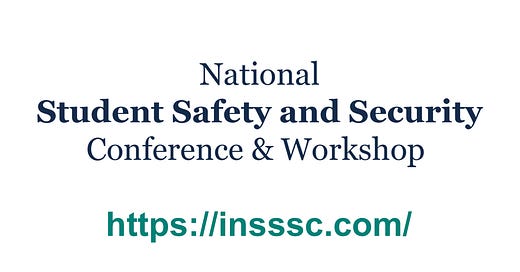National Conference Targets School Shootings and Youth Violence
I was just made aware of this series of conferences and workshops being hosted at multiple locations around the U.S. and wanted to share the information. I am not affiliated with this organization nor have I attended their conferences before, however, this looks like something other environmental health and safety professionals and emergency managers may be interested in attending or presenting at, as well as potential sponsorship opportunities for those interested. When it comes to student’s safety and security…we are all in this together. You can check out their 2024 Conference Brochure here.
More information about this group can be found on the About NSSSC webpage:
Every year more than 300 high school and university administrators, teachers, police chiefs, first responders, safety professionals, and community leaders attend the National Student Safety & Security Conference and Workshop.
Their objective is to identify and share best practices concerning school safety, and help model a community process to stamp out school violence in all its forms, including shootings, bullying, dating violence, vandalism, gang activity, and catastrophic events such as school massacres.
The conference will also include an important hands-on feature -- real-world simulations of community response to school shootings and related tragedies.
The tabletop exercises, moderated by risk communicators, will encourage extended audience participation and explore effective methods of communication, coordination and collaboration at the local level.
Role-Playing Topics Include:
Response: activating the emergency response infrastructure, warning signals, student complaints, first response, protecting targets and hostages, types of violence, survival techniques, news by cell phone, regaining control, chain of command, emergency response routes, evacuation procedures, school closings, notifying parents, anticipating escalation, law enforcement information sharing, medical procedures, dealing with the media, reaction on the Internet
Recovery: overcoming fear of returning to class, debriefings, victim needs, survivor needs, families of offenders, call-in lines, grief counseling, health services and resources, statements to students and parents, removing names, providing academic support, investigation procedures, funerals and anniversaries, signals for closure, how to orient new students and their families
Prevention: School Crime Watch, drug-free zones, gun-free zones, zero-tolerance messages, gang apparel and student dress codes, mentoring, parent cooperation, law enforcement resources and presentations, information kits and advisories, engaging the business sector, restrictions in hallways, locker areas, bathrooms, parking lots, cafeteria and other high-risk areas
Preparedness: “What You Can Do Right Now To Protect Your Students” — assessing threat and potential victims, designating crisis planning and crisis management teams, exercising the student safety plan, reviewing civil and criminal options, patrols and security systems, video monitoring, crime maps, creating a school safety who’s who, photo ID database, including private sector resources, dealing with outside threats, media relations, legislative actions, town hall meetings, releasing information, crisis kits, preparing the lines of communication, sharing best practices, taking preemptive action.
For more information, point to:




